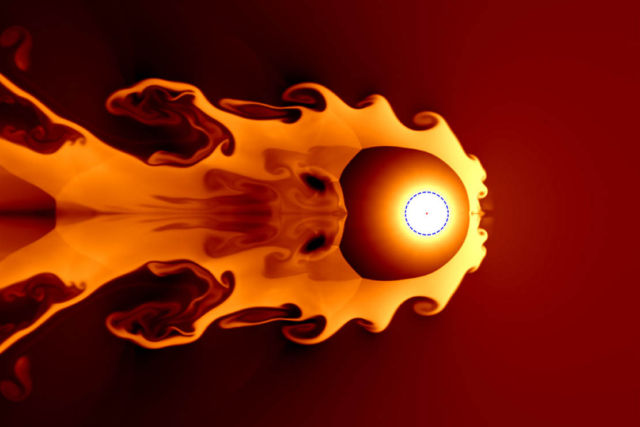An exploding star (supernova) about 65 light-years away may have caused mass extinction on Earth, 359 million years ago.
A team of researchers led by professor Brian Fields hypothesizes that a supernova about 65 light-years away may have contributed to the ozone depletion and subsequent mass extinction of the late Devonian Period, 359 million years ago.
Pictured is a simulation of a nearby supernova colliding with and compressing the solar wind. Earth’s orbit, the blue dashed circle, and the Sun, red dot, are shown for scale. Graphic courtesy Jesse Miller
The team concentrated on Devonian-Carboniferous boundary because those rocks contain hundreds of thousands of generations of plant spores that appear to be sunburnt by ultraviolet light – evidence of a long-lasting ozone-depletion event.
“Earth-based catastrophes such as large-scale volcanism and global warming can destroy the ozone layer, too, but evidence for those is inconclusive for the time interval in question,” Fields said. “Instead, we propose that one or more supernova explosions, about 65 light-years away from Earth, could have been responsible for the protracted loss of ozone.”
“To put this into perspective, one of the closest supernova threats today is from the star Betelgeuse, which is over 600 light-years away and well outside of the kill distance of 25 light-years,” said graduate student and study co-author Adrienne Ertel.
The team explored other astrophysical causes for ozone depletion, such as meteorite impacts, solar eruptions and gamma-ray bursts. “But these events end quickly and are unlikely to cause the long-lasting ozone depletion that happened at the end of the Devonian period,” said graduate student and study co-author Jesse Miller.
A supernova, on the other hand, delivers a one-two punch, the researchers said. The explosion immediately bathes Earth with damaging UV, X-rays and gamma rays. Later, the blast of supernova debris slams into the solar system, subjecting the planet to long-lived irradiation from cosmic rays accelerated by the supernova. The damage to Earth and its ozone layer can last for up to 100,000 years.
Graphic courtesy Jesse Miller
The findings are published in PNAS.






Leave A Comment